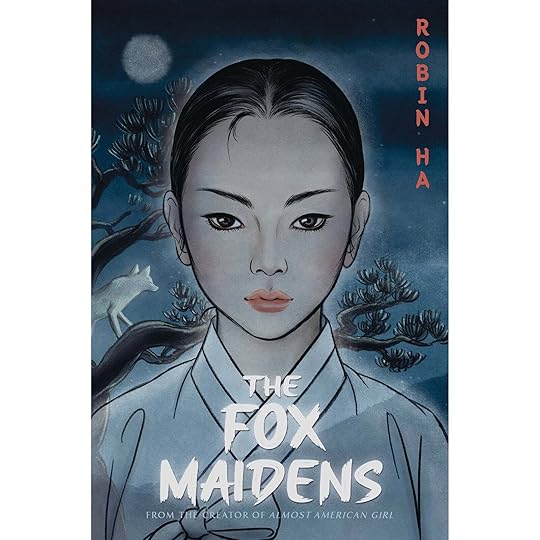Stephen Hong Sohn's Blog, page 7
October 14, 2024
A Review of Robin Ha’s Fox Maidens (HarperAlley, 2024)
![[personal profile]](https://i.gr-assets.com/images/S/compressed.photo.goodreads.com/hostedimages/1491408111i/22407843.png) lsobiesk
lsobiesk
Written by Stephen Hong Sohn
Edited by Lizzy Sobiesk
Ah, I’m so excited to be reviewing Robin Ha’s Fox Maidens (HarperAlley, 2024). I’ve taught Ha’s previous graphic narrative Almost American Girl quite a few times, and I am glad that she’s graced us with a second work. Here is the official marketing description: “Kai Song dreams of being a warrior. She wants to follow in the footsteps of her beloved father, the commander of the Royal Legion. But while her father believes in Kai and trains her in martial arts, their society isn’t ready for a girl warrior. Still, Kai is determined. But she is plagued by rumors that she is the granddaughter of Gumiho, the infamous nine-tailed fox demon who was killed by her father years before. Everything comes crashing down the day Kai learns the deadly secret about her mother’s past. Now she must come to terms with the truth about her identity and take her destiny into her own hands. As Kai desperately searches for a way to escape her fate, she comes to find compassion, and even love, in the most unexpected places.”
So, this graphic novel is set in the Joseon period, which I don’t know too much about. When I was working on Minor Salvage, I did have to delve into that period a little bit because of the remnants of the feudal period, which still largely operated in rural areas in the early 20th century in Korea. In any case, the Joseon period has been depicted in some YA literature. For instance, a number of June Hur’s YA works (which I don’t always read as YA; the protagonist just happens to be young) are set in that period. The feudal hierarchy was quite strict, with an actual slave class, which I didn’t know about prior to working on Minor Salvage. The nobi class appears in Fox Maidens as well, but Ha is quite happy to mess with some of the contextual dynamics in this period. The protagonist is certainly a Korean feminist action hero, whether or not she’s from the Joseon period or not LOL. One of the clear moments when I knew that Ha was really playing with some of the tropes of class occurred when Kai makes it a point to ensure that their housemaid (who is of the Nobi class) is treated respectfully and that her son, who would likewise be born into a lower class, would still have the possibility to train in the martial arts. In addition, Ha already mixes up traditional patriarchal dynamics by having Kai’s father be so open to having Kai train as a martial artist over and above having a career as a kisaeng (a Korean courtesan). For anyone who has grown up with a little bit of the cultural background of Korean myth and folklore, you already know about the fox demon. The fox demon is pretty much everywhere now in literary representations. You’ll find fox demon references in tons of Korean American literature; see, for instance, Alexander Chee’s Edinburgh, Nora Okja Keller’s Fox Girl, Kat Cho’s Wicked Fox and its sequel, and Sophie Kim’s God and the Gumiho. There was even a representation of the fox demon in the televisual adaptation of Lovecraft Country (with Jamie Chung playing the starring role). In any case, modern day considerations of the fox demon almost always play with the mythology. The fox demon is typically rendered as a patently evil figure. It’s not a surprise then that all of these writers, who are variously queer and/or female have been redefining this figure and giving her way more context to upturn previous assumptions about her monstrous morality. Such is also the case with Ha’s text, which is gorgeously illustrated and quite gothic in its visual representation. Certainly, this book is another that will get you in the mood for Halloween. A definite standout work, and one I will be assigning in the future =).
Buy the Book Here
 comments
comments
October 10, 2024
A Review of Kirstin Chen’s Counterfeit (William Morrow, 2022)
![[personal profile]](https://i.gr-assets.com/images/S/compressed.photo.goodreads.com/hostedimages/1491408111i/22407843.png) lsobiesk
lsobiesk
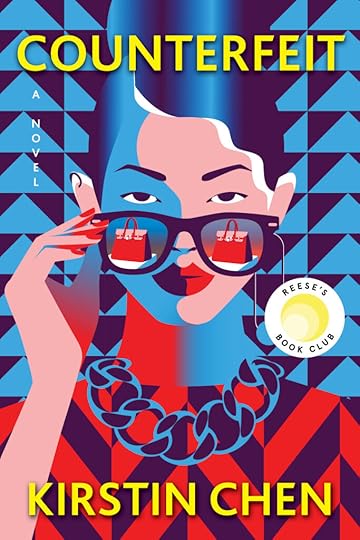
Written by Stephen Hong Sohn
Edited by Lizzy Sobiesk
As of late, there have been a ton of takedowns of the model minority myths, with an emphasis of folx working through underhanded means. In this case, the novel posits Ava as the proverbial model minority housewife, who is somehow roped into this designer handbag knockoff scheme. The novel’s set up is crucial to the way that Chen sets up readers for a major surprise. The first half of the novel is completed in a monological perspective, with Ava speaking in the first person as if she is being interviewed by a detective. Eventually, we know she has turned herself in, and she is using this narrative to explain why she was involved with Winnie in the first place. It becomes evident that Ava is detailing her connection because she wants to minimize her criminal involvement, with the hopes that she will receive lighter sentencing. Here, I will pause to let you know that I will be revealing some key spoilers, so look away unless you want to know how this one ends. Eventually, the novel turns to the third person perspective, and we see that Winnie is hiding out in China. She hopes to lay low until she can figure out her next move. We discover that Winnie is still in touch with Ava through burner phones that that Ava’s so-called “confession” is anything but. Indeed, Ava has been plotting a way through so that Ava might receive a lesser punishment, while Winnie takes the fall. Winnie’s part is to undergo cosmetic surgeries to ensure that she will look different enough, so that she can return to the United States under a different identity. The hope is that Ava and Winnie might work together on an alternative, legitimate business. The first half of the novel makes it seem like Winnie is the mastermind, but the shift reveals that both characters are quite clever, and that their working together is a sort of move toward a subversively constituted partnership that reminds one of Thelma and Louise. I especially appreciated this major shift, because the first half made me extremely suspicious of Ava, to the point where I am surprised that the plan actually worked. The whole time I had been thinking that Ava is making it seem like she had been manipulated by Winnie when it seemed as though Ava had way more agency than what was being communicated. In any case, Chen must have been anticipating this response, because it shows that Ava is already an unreliable narrator, which is where the novel ultimately moves. This ending does remind me about how strong Asian American female characters, who end up coming together in this way, come off as a very satisfying pairing that you actually do want to root for. The larger critiques that the novel seems to be making about elite consumption and global capitalism are harder to parse out, but there is a sense that the upwardly mobile Asian American is tasked with reconsidering her place in a larger social structure in which she can (or not) be an agent for social justice in some capacity.
Buy the Book Here
 comments
comments
October 9, 2024
A Review of Hua Hsu’s Stay True (Doubleday, 2022)
![[personal profile]](https://i.gr-assets.com/images/S/compressed.photo.goodreads.com/hostedimages/1491408111i/22407843.png) lsobiesk
lsobiesk
Written by Stephen Hong Sohn
Edited by Lizzy Sobiesk
I have been meaning to read Hua Hsu’s Stay True (Doubleday, 2022) for quite some time. Of course, by the point where I managed to carve out some space to do so, the memoir had received the Pulitzer Prize in nonfiction! Congratulations to Hsu!! Let’s first start off with the marketing description as per usual: “In the eyes of eighteen-year-old Hua Hsu, the problem with Ken—with his passion for Dave Matthews, Abercrombie & Fitch, and his fraternity—is that he is exactly like everyone else. Ken, whose Japanese American family has been in the United States for generations, is mainstream; for Hua, the son of Taiwanese immigrants, who makes ’zines and haunts Bay Area record shops, Ken represents all that he defines himself in opposition to. The only thing Hua and Ken have in common is that, however they engage with it, American culture doesn’t seem to have a place for either of them. But despite his first impressions, Hua and Ken become friends, a friendship built on late-night conversations over cigarettes, long drives along the California coast, and the successes and humiliations of everyday college life. And then violently, senselessly, Ken is gone, killed in a carjacking, not even three years after the day they first meet. Determined to hold on to all that was left of one of his closest friends—his memories—Hua turned to writing. Stay True is the book he’s been working on ever since. A coming-of-age story that details both the ordinary and extraordinary, Stay True is a bracing memoir about growing up, and about moving through the world in search of meaning and belonging.”
For me, this memoir had this eerie quality only because Hsu and I are of a similar age, so the many references that occur in this work are not unfamiliar to me. I was brought back to some of my own college experiences and the tight bonds that one constructs in that period. For Hsu, the memoir is a chance for him to detail his burgeoning identifications, whether it is related to his interest in theory, music, or Asian American Studies. The big takeaway for me is that the memoir helps document a period of time when the academic pursuit of ethnic studies is not so radical. As a memoir about friendship, the work is incredibly immersive, and by the time we are well onto the memoir’s final sections, we are caught up in the immense wake of grief that subsumes Hsu and all those whose lives were touched by Ken. In this way, one of Hsu’s greatest interventions exists simply in the detailed archiving of Ken’s life, reaching across time to ensure that Ken and his zest to live in the moment will not be forgotten.
Buy the Book Here
 comments
comments
October 7, 2024
A Review of Sarah Suk’s The Space Between Here & Now (Quill Tree, 2023)
![[personal profile]](https://i.gr-assets.com/images/S/compressed.photo.goodreads.com/hostedimages/1491408111i/22407843.png) lsobiesk
lsobiesk
Edited by Lizzy Sobiesk
Well, I’m so glad to be reviewing Sarah Suk’s The Space Between Here & Now (Quill Tree, 2023), because I haven’t been on top of YA fiction lately. I always forget how pleasurable they can be to read. In any case, as per usual, I offer the marketing description here to ground us: “Seventeen-year-old Aimee Roh has Sensory Time Warp Syndrome, a rare condition that causes her to time travel to a moment in her life when she smells something linked to that memory. Her dad is convinced she’ll simply grow out of it if she tries hard enough, but Aimee’s fear of vanishing at random has kept her from living a normal life. When Aimee disappears for nine hours into a memory of her estranged mom—a moment Aimee has never remembered before—she becomes distraught. Not only was this her longest disappearance yet, but the memory doesn’t match up with the story of how her mom left—at least, not the version she’s always heard from her dad. Desperate for answers, Aimee travels to Korea, where she unravels the mystery of her memories, the truth about her mother, and the reason she keeps returning to certain moments in her life. Along the way, she realizes she’ll need to reconcile her past in order to save her present.”
So, one might consider Suk’s YA novel a kind of low-intensity speculative fiction, possibly even a low fantasy. The speculative element is of course the Sensory Time Warp Syndrome. This “syndrome” sort of reads as a disease, and there is certainly a queer element to it, as people who are afflicted with it may not even want to reveal that they are suffering from it. And by, suffering, I do mean the fact that people who undergo time traveling within their memory disappear for a length of time from the present. They only reappear when they have finished re-experiencing their memories. The speculative conceit is really interesting and simultaneously limiting, in the sense that Aimee cannot change anything from her past. She can only observe, almost from a third person perspective. As Aimee continues to suffer from these episodes of time-warping, she decides she must travel to Korea; she believes her mother might hold answers. Indeed, she begins to wonder if there is a genetic link to the syndrome and that perhaps her mother might have the syndrome herself. The journey to Korea is obviously fraught; her father doesn’t want to go, but eventually relents. While there, Aimee must find the courage to face some deep family secrets. I won’t spoil the ending here, but I’m most impressed by the textured portrayal of a single Korean immigrant father’s relationship with his child. Suk’s story is full of poignant moments that feel well-earned. The added bonus is how she weaves in the speculative dimensions. Indeed, one of the most intriguing things that readers discover is that those with this syndrome can sometimes drop into each other’s memories, especially if they occurred at a similar time and place. Others can become trapped in the past and be stuck in a kind of time loop. These elements make this YA novel filled with realist pathos and speculative whimsy. Certainly, this is one of those YA novels that rises to the level of a narrative you might want to teach in a classroom.
Buy the Book Here
 comments
comments
October 3, 2024
A Review of Kirstin Chen’s Counterfeit (William Morrow, 2022)
![[personal profile]](https://i.gr-assets.com/images/S/compressed.photo.goodreads.com/hostedimages/1491408111i/22407843.png) lsobiesk
lsobiesk
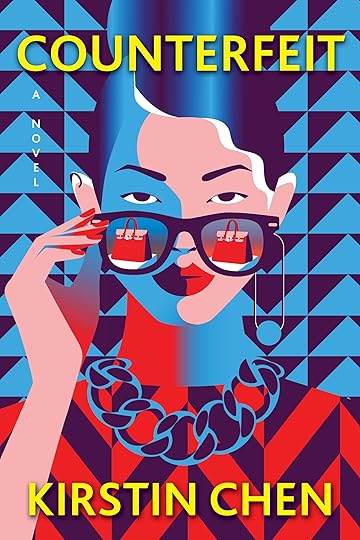
Written by Stephen Hong Sohn
Edited by Lizzy Sobiesk
I’ve been meaning to read Kirstin Chen’s Counterfeit (William Morrow, 2022) for quite some time, and I managed to cover it this summer while I’ve been playing catch up! Let’s let the marketing description provide us with our introduction: “Ava Wong has always played it safe. As a strait-laced, rule-abiding Chinese American lawyer with a successful surgeon as a husband, a young son, and a beautiful home—she’s built the perfect life. But beneath this façade, Ava’s world is crumbling: her marriage is falling apart, her expensive law degree hasn’t been used in years, and her toddler’s tantrums are pushing her to the breaking point. Enter Winnie Fang, Ava’s enigmatic college roommate from Mainland China, who abruptly dropped out under mysterious circumstances. Now, twenty years later, Winnie is looking to reconnect with her old friend. But the shy, awkward girl Ava once knew has been replaced with a confident woman of the world, dripping in luxury goods, including a coveted Birkin in classic orange. The secret to her success? Winnie has developed an ingenious counterfeit scheme that involves importing near-exact replicas of luxury handbags and now she needs someone with a U.S. passport to help manage her business—someone who’d never be suspected of wrongdoing, someone like Ava. But when their spectacular success is threatened and Winnie vanishes once again, Ava is left to face the consequences. Swift, surprising, and sharply comic, Counterfeit is a stylish and feminist caper with a strong point of view and an axe to grind. Peering behind the curtain of the upscale designer storefronts and the Chinese factories where luxury goods are produced, Kirstin Chen interrogates the myth of the model minority through two unforgettable women determined to demand more from life.”
As of late, there have been a ton of takedowns of the model minority myths, with an emphasis of folx working through underhanded means. In this case, the novel posits Ava as the proverbial model minority housewife, who is somehow roped into this designer handbag knockoff scheme. The novel’s set up is crucial to the way that Chen sets up readers for a major surprise. The first half of the novel is completed in a monological perspective, with Ava speaking in the first person as if she is being interviewed by a detective. Eventually, we know she has turned herself in, and she is using this narrative to explain why she was involved with Winnie in the first place. It becomes evident that Ava is detailing her connection because she wants to minimize her criminal involvement, with the hopes that she will receive lighter sentencing. Here, I will pause to let you know that I will be revealing some key spoilers, so look away unless you want to know how this one ends. Eventually, the novel turns to the third person perspective, and we see that Winnie is hiding out in China. She hopes to lay low until she can figure out her next move. We discover that Winnie is still in touch with Ava through burner phones that that Ava’s so-called “confession” is anything but. Indeed, Ava has been plotting a way through so that Ava might receive a lesser punishment, while Winnie takes the fall. Winnie’s part is to undergo cosmetic surgeries to ensure that she will look different enough, so that she can return to the United States under a different identity. The hope is that Ava and Winnie might work together on an alternative, legitimate business. The first half of the novel makes it seem like Winnie is the mastermind, but the shift reveals that both characters are quite clever, and that their working together is a sort of move toward a subversively constituted partnership that reminds one of Thelma and Louise. I especially appreciated this major shift, because the first half made me extremely suspicious of Ava, to the point where I am surprised that the plan actually worked. The whole time I had been thinking that Ava is making it seem like she had been manipulated by Winnie when it seemed as though Ava had way more agency than what was being communicated. In any case, Chen must have been anticipating this response, because it shows that Ava is already an unreliable narrator, which is where the novel ultimately moves. This ending does remind me about how strong Asian American female characters, who end up coming together in this way, come off as a very satisfying pairing that you actually do want to root for. The larger critiques that the novel seems to be making about elite consumption and global capitalism are harder to parse out, but there is a sense that the upwardly mobile Asian American is tasked with reconsidering her place in a larger social structure in which she can (or not) be an agent for social justice in some capacity.
Buy the Book Here
 comments
comments
October 2, 2024
A Review of Miranda Sun’s If I Have to be Haunted (HarperTeen, 2023)
![[personal profile]](https://i.gr-assets.com/images/S/compressed.photo.goodreads.com/hostedimages/1491408111i/22407843.png) lsobiesk
lsobiesk

Written by Stephen Hong Sohn
Edited by Lizzy Sobiesk
Well, if you’re looking to get into the Halloween spirit, look no further than Miranda Sun’s If I Have to be Haunted (HarperTeen, 2023), which will definitely get you in the mood. Let’s let the official marketing description do some work to get us situated: “Cara Tang doesn’t want to be haunted. Look, the dead have issues, and Cara has enough of her own. Her overbearing mother insists she be the ‘perfect’ Chinese American daughter—which means suppressing her ghost-speaking powers—and she keeps getting into fights with Zacharias Coleson, the local golden boy whose smirk makes her want to set things on fire. Then she stumbles across Zach’s dead body in the woods. He’s even more infuriating as a ghost, but Cara’s the only one who can see him—and save him. Agreeing to resurrect him puts her at odds with her mother, draws her into a dangerous liminal world of monsters and magic—and worse, leaves her stuck with Zach. Yet as she and Zach grow closer, forced to depend on each other to survive, Cara finds the most terrifying thing is that she might not hate him so much after all. Maybe this is why her mother warned her about ghosts.”
This overview is interesting insofar as it sort of codes Cara’s ghost-speaking powers as detrimental to the model minority stereotype. In some sense, it reminds us of why superpowers are sometimes seen as a metaphorical approach to queerness, as Cara is sort of in the ghost-speaking closet. This novel is primarily a low fantasy, portal fantasy quest plot, with Cara and Zach having to team up—at first unwillingly—in order for them to find a solution to Zach’s fate. At first, I thought the novel was going to be much more lighthearted, especially as the banter between Zach and Cara charged up the comedy factor, but this novel gets quite dark. The underworld locations that Sun has created are not for the faint of heart; there are mountain-entities, fog creatures, and spirits that are up to no good, so the ending sequence will be well-earned. If there is a critique of this novel, then it is precisely also a strength (and here, I leave you with a spoiler alert, so look away unless you want to know the ending). As many of you know (and for those that have read my many reviews about paranormal YA), the formula almost requires a romance plot despite the fact that there are so many things that the protagonist must do in order to survive. In this case, I already liked the fact that the two characters didn’t like each other at the beginning. I knew that the formula often necessitates the romance plot, but I frankly didn’t think it was needed here. On some level, I would have thought too that there would have been more resistance to the Zach and Cara’s coupling from the larger high school community. Given that this novel seems to be the first of a series, I do think Sun could have dragged this one out for at least another installment only because there was enough to worry about just on the level of Zach and Cara’s lives to fill the plot and, I think, command enough attention from readers. I do understand the adherence to formula, and there’s also something quite comforting in knowing that your leads will find a way to each other as well, so I obviously show some ambivalence. I mostly enjoyed the world-building aspects, which are flexible here. Indeed, by novel’s end, you begin to realize that there is more elasticity not only to the world of ghosts, but the powers that the living might have, which seem all the more pertinent to whatever is in store for Cara and Zach in the next one.
Buy the Book Here
 comments
comments
September 26, 2024
A Review of Tara Sim’s The Midnight Kingdom (Orbit, 2023)
![[personal profile]](https://i.gr-assets.com/images/S/compressed.photo.goodreads.com/hostedimages/1491408111i/22407843.png) lsobiesk
lsobiesk
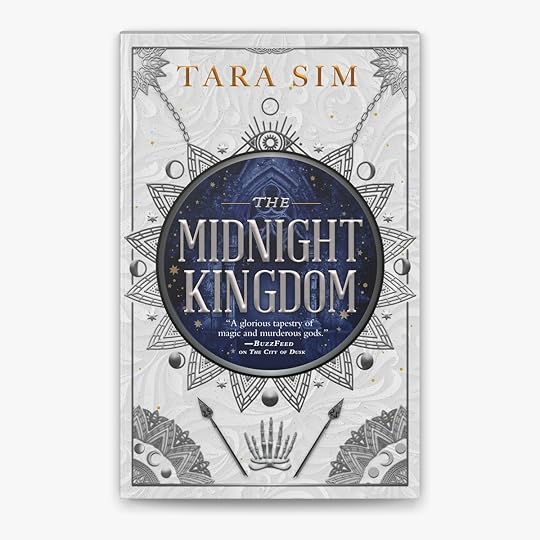
Written by Stephen Hong Sohn
Edited by Lizzy Sobiesk
Ah, so now I am reviewing Tara Sim’s The Midnight Kingdom (Orbit, 2023), which is the second installment in the Dark Gods series. The marketing description for this one is far more robust, which I appreciate, but there is also a lot more plot in this second book, so I’m not surprised: “A cataclysmic battle to save the city of Nexus has left the four noble heirs scattered across the realms. Taesia, the shadow-wielding rebel of House Lastrider, and Nikolas, the reluctant soldier of House Cyr, have been cast into Noctus, the realm of eternal night. But they are not alone. The dangerous and unpredictable god of light has traveled with them, and he will do anything in his power to destroy Noctus in his bid for cosmic control. Risha, the peacekeeping necromancer of House Vakara, must navigate her way through Mortri, the realm of death. But still she cannot help the wayward spirits, nor does she have any idea how to return home. All she knows is that no mortal can survive for long in Mortri. And the creatures that prowl the realm of death don't take kindly to the living. Angelica, the stubborn elementalist of House Mardova, is on her own in Vitae, trying to keep Nexus from unraveling. But Angelica secretly suffers from an illness that her god left in her veins. And when she is sent on a delicate diplomatic mission, she knows that any weakness will have disastrous repercussions for her family, her kingdom, and her dreams of the throne. All will encounter old friends and new enemies as they attempt to restore the balance of the universe. But the gods grow stronger. And their descendants will need more than their magic and their wits to survive the war that is coming…”
I’m going to start off with my critique first, just because I was in a bad way for a good 350 pages of this novel. And let me be clear: Sim’s worldbuilding is meticulous and complex, so there’s much to praise, but I need to let out my feelings haha! In any case, there is that one season of Stranger Things, where the “Scooby gang,” is essentially all separated for the most of that period. You desperately want them back together, partly because their interactions are fun, and their snarkiness is partly what drew you to them in the first place. Such is also the case with this novel, which seems almost more like 4 novels mashed into one. Whereas the prior novel did suffer somewhat from the shifting third person perspective, this one has the extra added complication of the fact that the characters can rarely interact with one another. Sim does have one major trick up her sleeve to help mollify readers who want these different storylines to intersect more often: Brailee, who can use her dreams to contact people in other realms. Because we have four sustained plots of equal weight, readers are sometimes in the position of finding themselves liking one of those storylines more than the others. In my case, because Risha’s storyline in the underworld was so separated from all of the others, I found myself impatient to get through her sections. Then, the weight of some storylines seemed more hefty than others. Dante, Brailee, and Saya find themselves in Seniza trying to track down their rogue Aunt, who had been a major problem in the first novel. They seek to find a way to generate a portal to another realm that would allow them perhaps to connect with Taesia, Julian, and Nikolas. This storyline didn’t have the same urgency as the one involving Taesia, Julian, and Nikolas, who are stuck in Noctus together, and who have the extra added weight of constantly having to fight a god, while also hoping to save that realm from annihilation. Now that my quibbles have been revealed, I want to end on an unequivocally positive note: the concluding sequence is a smash. So much going on, so much action, that you wonder how the last 150 pages might look on an IMAX screen. You have wyverns and other flying creatures, humans with superpowers fighting gods, and the universal emotions like love and grief that stir us to make such difficult choices and decisions. The conclusion to this one seemed to leave fewer loose ends than the first, so it’ll be very interesting to see exactly where Sim goes with the last book. I’ll certainly be there!
Buy the Book Here
 comments
comments
September 25, 2024
A Review of Tara Sim’s The City of Dusk (Orbit, 2022)
![[personal profile]](https://i.gr-assets.com/images/S/compressed.photo.goodreads.com/hostedimages/1491408111i/22407843.png) lsobiesk
lsobiesk
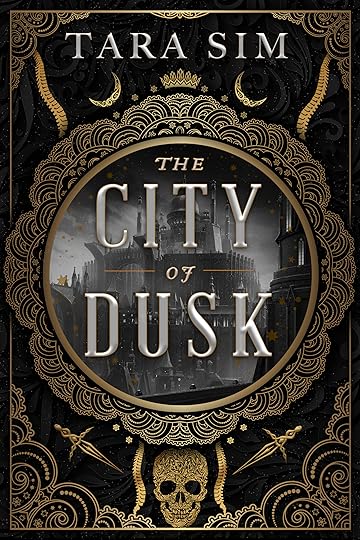
Written by Stephen Hong Sohn
Edited by Lizzy Sobiesk
This excerpt is pretty pithy. There are a bunch of other major characters. For instance, some of the houses have multiple heirs. Taesia has a brother Dante, who could also be an heir, as well as a younger sister named Brailee. When Dante gets jailed (due to the assumption that he was engaging in an outlawed practice called conjuration), the expectation is that Taesia would become the heir. Risha also has a younger sister named Saya. Nikolas is still dealing with the death of his little brother Rian. Despite the battle over who will eventually rule over Vitae, the “once vibrant and thriving metropolis,” the four heirs are not necessarily interested in becoming the sole ruler. Indeed, they often hang out with each other and in some cases seem more interested in figuring out how to fix Vitae rather than being a powerful leader. Well into the novel, Sim introduces another important character named Julian, who is a “beastspeaker,” which is a person who is able to communicate with animals. Here, I will provide a major spoiler warning, so look away unless you want to find out major plot details. Julian, as readers discover, is also an heir, but of a fifth realm that had not been spoken about and had been destroyed, called Ostium. The five heirs must find a way to work together to figure out how to undo something called the Sealing, which is the word used to describe how Vitae is now cut off from other realms, which is leading to each realm slowly dying. The best date to undo the Sealing is Godsnight, so they target that specific event in order to try to undo the Sealing. What the heirs do not realize is that the Gods of each realm have been planning all along to cement their own powers and that the heirs are only meant to be conduits that they are ultimately going to be taking over. My major critique of this text and the next is the pacing: I found myself impatient with some of the exposition. There is a quite a lot needed because of the world building and the background is needed to understand what has gone on with the Gods. The other issue that exacerbates the pacing is the use of third person, which shifts consistently between at least five characters. Sim’s strength is that she goes all in with her world building, giving texture to the four different houses through their unique powers. The conclusion is also quite cataclysmic and easily pushes you into reading the next.
Buy the Book Here
 comments
comments
September 24, 2024
A Review of Fonda Lee’s Jade Legacy (Orbit, 2021)
![[personal profile]](https://i.gr-assets.com/images/S/compressed.photo.goodreads.com/hostedimages/1491408111i/22407843.png) lsobiesk
lsobiesk
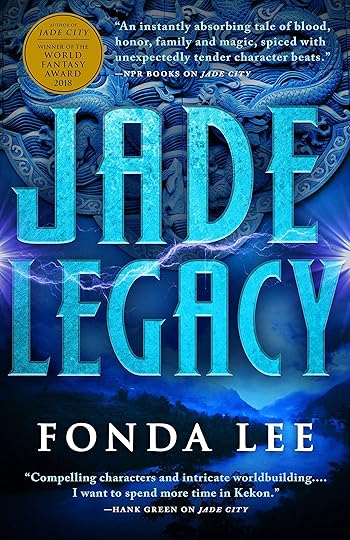
Written by Stephen Hong Sohn
Edited by Lizzy Sobiesk
Let me begin by stating: Well, I’m sad to say that I’ve completed the Green Bone Saga. I’m sad because it was so immersive! In any case, as per usual, the official marketing description is pretty basic: “Jade, the mysterious and magical substance once exclusive to the Green Bone warriors of Kekon, is now coveted throughout the world. Everyone wants access to the supernatural abilities it provides. As the struggle over the control of jade grows ever larger and more deadly, the Kaul family, and the ancient ways of the Kekonese Green Bones, will never be the same. Battered by war and tragedy, the Kauls are plagued by resentments and old wounds as their adversaries are on the ascent and their country is riven by dangerous factions and foreign interference. The clan must discern allies from enemies, set aside bloody rivalries, and make terrible sacrifices . . . but even the unbreakable bonds of blood and loyalty may not be enough to ensure the survival of the Green Bone clans and the nation they are sworn to protect.”
Again, the excerpt fails to mention any major characters. Oh, and I suppose I should note that there will be spoilers forthcoming, so I would look away now (unless you don’t mind some of the plot elements being revealed). I think the big disappointment in this installment is that I felt that one of the minor characters (Bero) was going to end up doing something far more impactful in terms of the plot. Bero was one of the few POVS beyond the major Kaul family characters that tracked across all three of the novels. My guess is that Lee may have had bigger plans for this character but changed somewhere midstream precisely because she already had enough to deal with in the war between the Green Bone and Mountain clans. To be sure, Bero does have one important plot function related to the clanless Kekonese, and it involves helping to mastermind a major bombing on a place filled with both politicians and clan leaders. In fact, this portion was perhaps one of the most intense sequences in this narrative. Also, this last installment is by far the longest, and I’m sure a testament to the fact that such multi-part sagas can be difficult to pace. In any case, the main POVs are given to Shae, Hilo, and Anden as per usual. The transnational dynamics that were a part of the previous installment are still at play. The Green Bones are seeking a way to gain a foothold in the trade of jade in Espenia. If jade is allowed to be used in some form in Espenia, then the Green Bone clan would gain a major economic advantage over their rival clan and, at the same time, continue to open up new markets. The other element that is important to note is that Lee covers way more time in this novel, with the Kaul heirs beginning to grow up. Recall that Hilo (and wife Wen) have essentially raised Lan’s son (Niko) as their own. Their second son, Ru, ends up being a stone-eye, which is the term for a Kekonese with no ability to use jade and its special skill-enhancing abilities, while Jaya, their daughter, ends up wanting to become part of the “muscle” of the clan, moving into the line of becoming a Fist. One of the most tragic sequences involves Ru’s death, which ultimately leads to an important rapprochement. Niko, having estranged himself from the family, eventually returns. The ending sequence is quite masterful, with Lee having known all along how the narrative would end and how the payoff would feel best. We know that Hilo has lived his life, wielding violence as one of his most important tools to keep both allies and foes in line, but that approach will end up costing him to a certain extent. By novel’s end, I was certainly quite wistful, as I’d grown very attached to the characters. Lee shows her range as a writer, moving beyond the more confined bounds of the YA plot and ensuring her place in the silkpunk, high fantasy canon with the Green Bone Saga. I look forward to whatever she is cooking up next!
Buy the Book Here
 comments
comments
September 21, 2024
A Review of Fonda Lee’s Jade War (Orbit, 2019)
![[personal profile]](https://i.gr-assets.com/images/S/compressed.photo.goodreads.com/hostedimages/1491408111i/22407843.png) lsobiesk
lsobiesk
[image error]
Written by Stephen Hong Sohn
Edited by Lizzy Sobiesk
I read the second installment of Fonda Lee’s Green Bone saga—Jade War—as soon as I finished the first. The third installment unfortunately is still en route! But I digress —here is the marketing description: “On the island of Kekon, the Kaul family is locked in a violent feud for control of the capital city and the supply of magical jade that endows trained Green Bone warriors with supernatural powers they alone have possessed for hundreds of years. Beyond Kekon's borders, war is brewing. Powerful foreign governments and mercenary criminal kingpins alike turn their eyes on the island nation. Jade, Kekon's most prized resource, could make them rich - or give them the edge they'd need to topple their rivals. Faced with threats on all sides, the Kaul family is forced to form new and dangerous alliances, confront enemies in the darkest streets and the tallest office towers, and put honor aside in order to do whatever it takes to ensure their own survival—and that of all the Green Bones of Kekon.”
These pithy descriptions don’t even mention a single character, which is interesting. Again, the anchor of this book is much like the last, with the focus on the Kauls and their attempts to retain power on Kekon, especially with respect to their rivals (the Mountain Clan and their leader Ayt). To keep up with the enemy clan, Shae has helped establish an international trade route for jade, while Helo continues to maintain whatever power he has on Kekon. Anden has been moved to what seems to be a kind of analogue for a European nation, which is called Espenia in this novel. I will be providing spoilers throughout this review, so look away unless you want to find out more about this particular plot. Much like the last novel, I found myself gravitating toward Shae’s and Anden’s plots the most. In this case, Shae is navigating a complicated romantic relationship with a Green Bone who has become a professor. Anden, who we discover is queer in the last novel, is also coming to terms with his sexuality in this novel, as he starts a relationship with the son of a Kekonese immigrant. While all of these relationships evolve, the battle between the clans continues to brew. Lee sets up this novel so a side character that opens up this text ends up becoming a major antagonist. This character leads readers up to the climax point, where Anden is used to try to take him down. Helo’s wife, Wen, wants to be a part of the action (and begs Shae to let her help the clan even though Shae knows that Helo wouldn’t allow it), because this antagonist had a part in killing her brother. Wen, Anden, and a fellow Green Bone from an Espenian clan are able to take the antagonist down, but Wen is seriously injured (with brain damage), while the Espenian Green Bone loses his life. The ending sees Helo try to get rid of Shae as his Weather Man, but they come to a sort of rapprochement, realizing that they need to work this out if they are to have any chance against Ayt. Indeed, it is revealed that this novel’s major antagonist was indirectly supported by Ayt, and Ayt continues to try to consolidate her power, not only through clan warfare and but also through political gamesmanship. Again, Lee shows her tremendous skill in toggling so many perspectives and plots. The shift to the international dynamics of the jade trade also provides extra texture to this fictional world. In this case, Lee definitely offers up instances of racial formation in the Espenian context, with Anden experiencing what it is like to be an immigrant. Again, texts like this one bring up the question of the utility of presenting racial formation in the high fantasy context. Ultimately, it is another thrilling story, one that certainly sets up what will likely be a cataclysmic conclusion.
Buy the Book Here
 comments
comments

